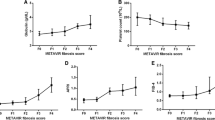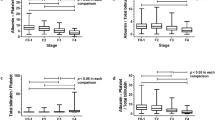Abstract
Aims
We investigated the correlation between the red cell distribution width (RDW) and RDW-to-platelet ratio (RPR) with the degree of inflammation and fibrosis in chronic hepatitis patients with different etiologies and in native and transplanted liver.
Methods
Between 2010 and 2013, patients from the MedStar Washington Hospital Center and Georgetown University Hospital with chronic hepatitis B, chronic hepatitis C, alcoholic hepatitis, and primary biliary cirrhosis who had a biopsy of the liver done in this time period were included. The correlation among the RDW, RPR, and model for end-stage liver disease (MELD) score with the degree of liver inflammation, fibrosis, and cirrhosis in separate groups of native and transplanted liver was calculated.
Results
A total of 152 cases with native liver and 70 cases with transplanted liver were included. The majority of patients had hepatitis C in both groups. None of the investigated variables showed significant correlation with the degree of inflammation in either group. The strongest correlation with the degree of fibrosis in the native liver group was for the RPR with 0.51 (p < 0.001) and then the RDW and MELD with 0.34 (p < 0.001) and 0.31 (p < 0.001), respectively. In the transplanted liver group, none of the variables showed significant correlation with the degree of fibrosis. The receiver-operator curve showed that only the RDW and RPR in the native liver group, with areas under the curve of 0.770 and 0.684, respectively, have significantly positive association with the risk of cirrhosis. In the transplanted group, none of the predictors were associated with risk of cirrhosis. In the native liver group, a cutoff value of 0.088 in the RPR led to 82.7 % sensitivity and 61.0 % specificity to predict cirrhosis.
Conclusion
The RPR can be a strong predictor of the degree of fibrosis and cirrhosis in patients with chronic hepatitis and native liver. It shows higher accuracy compared to the RDW and MELD score. However, its use in predicting inflammation is limited.


Similar content being viewed by others
References
Zalawadiya SK, Veeranna V, Niraj A, Pradhan J, Afonso L. Red cell distribution width and risk of coronary heart disease events. Am J Cardiol 2010;106:988–993
Patel KV, Ferrucci L, Ershler WB, Longo DL, Guralnik JM. Red blood cell distribution width and the risk of death in middle-aged and older adults. Arch Intern Med 2009;169:515–523
Horne BD. A changing focus on the red cell distribution width: why does it predict mortality and other adverse medical outcomes? Cardiology 2012;122:213–215
Bojakowski K, Dzabic M, Kurzejamska E, Styczynski G, Andziak P, et al. A high red blood cell distribution width predicts failure of arteriovenous fistula. PLoS One 2012;7:e36482
Lou Y, Wang M, Mao W. Clinical usefulness of measuring red blood cell distribution width in patients with hepatitis B. PLoS One 2012;7:e37644
Karagoz E, Ulcay A, Tanoglu A, Kara M, Turhan V, et al. Clinical usefulness of mean platelet volume and red blood cell distribution width to platelet ratio for predicting the severity of hepatic fibrosis in chronic hepatitis B virus patients. Eur J Gastroenterol Hepatol 2014;26:1320–1324
Huang R, Yang C, Wu K, Cao S, Liu Y, et al. Red cell distribution width as a potential index to assess the severity of hepatitis B virus-related liver diseases. Hepatol Res 2014;44:E464–E470
Chen B, Ye B, Zhang J, Ying L, Chen Y. RDW to platelet ratio: a novel noninvasive index for predicting hepatic fibrosis and cirrhosis in chronic hepatitis B. PLoS One 2013;8:e68780
Malinchoc M, Kamath PS, Gordon FD, Peine CJ, Rank J, et al. A model to predict poor survival in patients undergoing transjugular intrahepatic portosystemic shunts. Hepatology 2000;31:864–871
Kamath PS, Wiesner RH, Malinchoc M, Kremers W, Therneau TM, et al. A model to predict survival in patients with end-stage liver disease. Hepatology 2001;33:464–470
Kamath PS, Kim WR, Advanced Liver Disease Study G. The model for end-stage liver disease (MELD). Hepatology. 2007;45:797–805
Batts KP, Ludwig J. Chronic hepatitis. An update on terminology and reporting. Am J Surg Pathol 1995;19:1409–1417
DeLong ER, DeLong DM, Clarke-Pearson DL. Comparing the areas under two or more correlated receiver operating characteristic curves: a nonparametric approach. Biometrics 1988;44:837–845
Youden WJ. Index for rating diagnostic tests. Cancer 1950;3:32–35
Huo TI, Wu JC, Lin HC, Lee FY, Hou MC, et al. Evaluation of the increase in model for end-stage liver disease (DeltaMELD) score over time as a prognostic predictor in patients with advanced cirrhosis: risk factor analysis and comparison with initial MELD and Child-Turcotte-Pugh score. J Hepatol 2005;42:826–832
Karnad A, Poskitt TR. The automated complete blood cell count. Use of the red blood cell volume distribution width and mean platelet volume in evaluating anemia and thrombocytopenia. Arch Intern Med 1985;145:1270–1272
Thompson WG, Meola T, Lipkin M Jr, Freedman ML. Red cell distribution width, mean corpuscular volume, and transferrin saturation in the diagnosis of iron deficiency. Arch Intern Med 1988;148:2128–2130
Evans TC, Jehle D. The red blood cell distribution width. J Emerg Med 1991;9(Suppl 1):71–74
McHutchison JG, Manns MP, Longo DL. Definition and management of anemia in patients infected with hepatitis C virus. Liver Int 2006;26:389–398
Lippi G, Targher G, Montagnana M, Salvagno GL, Zoppini G, et al. Relation between red blood cell distribution width and inflammatory biomarkers in a large cohort of unselected outpatients. Arch Pathol Lab Med 2009;133:628–632
Allen LA, Felker GM, Mehra MR, Chiong JR, Dunlap SH, et al. Validation and potential mechanisms of red cell distribution width as a prognostic marker in heart failure. J Card Fail 2010;16:230–238
Coursaget P, Buisson Y, N’Gawara MN, Van Cuyck-Gandre H, Roue R. Role of hepatitis E virus in sporadic cases of acute and fulminant hepatitis in an endemic area (Chad). Am J Trop Med Hyg 1998;58:330–334
Knight V, Tchongue J, Lourensz D, Tipping P, Sievert W. Protease-activated receptor 2 promotes experimental liver fibrosis in mice and activates human hepatic stellate cells. Hepatology 2012;55:879–887
Acknowledgements
This project was funded in part by federal funds (grant no. UL1TR000101, previously UL1RR031975) from the National Center for Advancing Translational Sciences (NCATS), National Institutes of Health (NIH), through the Clinical and Translational Science Awards Program (CTSA), a trademark of DHHS, part of the Roadmap Initiative, “Re-Engineering the Clinical Research Enterprise.”
Compliance with Ethical Requirements and Conflict of interest
All procedures followed were in accordance with the ethical standards of the responsible committee on human experimentation (institutional and national) and with the Helsinki Declaration of 1975, as revised in 2008 (5). This study was reviewed and approved by the Institutional Review Board of MesdStar Health Research Institute. Amir Taefi, Chun-Chih Huang, Kirthi Kolli, Suzan Ebrahimi, and Mitesh Patel declare that they have no conflict of interests.
Author information
Authors and Affiliations
Corresponding author
Rights and permissions
About this article
Cite this article
Taefi, A., Huang, CC., Kolli, K. et al. Red cell distribution width to platelet ratio, a useful indicator of liver fibrosis in chronic hepatitis patients. Hepatol Int 9, 454–460 (2015). https://doi.org/10.1007/s12072-015-9638-9
Received:
Accepted:
Published:
Issue Date:
DOI: https://doi.org/10.1007/s12072-015-9638-9




